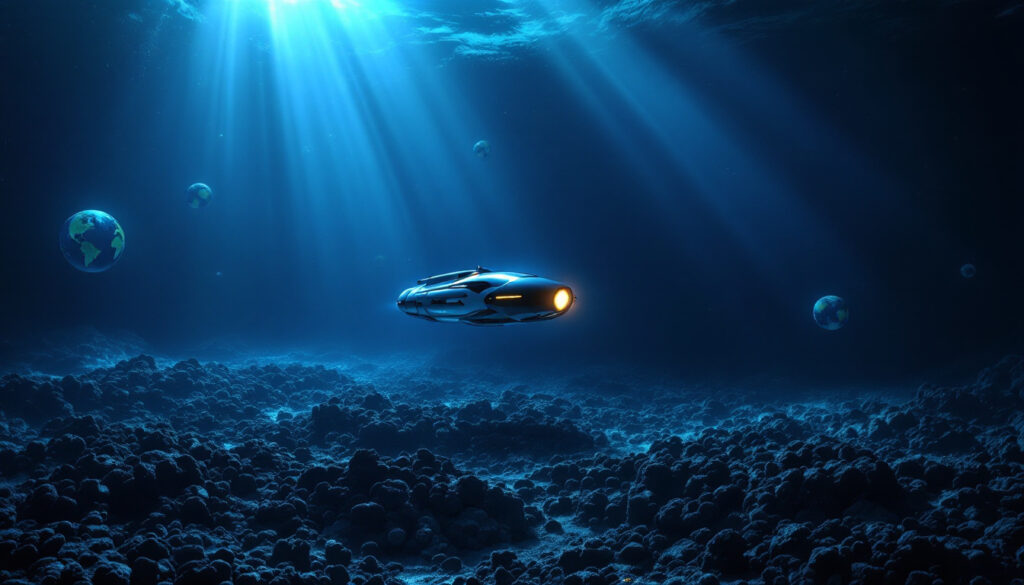What is Deep Sea Mining and Why is it Controversial?
Deep sea mining represents one of the most contentious frontiers in resource extraction, targeting valuable mineral deposits from previously untouched ocean ecosystems. At the heart of this emerging industry are polymetallic nodules—potato-sized rocks containing critical minerals essential for green technologies, including cobalt, nickel, copper, and manganese. These nodules, which took millions of years to form, lie scattered across vast areas of the abyssal plains at depths exceeding 4,000 meters.
The regulatory framework governing this activity falls primarily under the International Seabed Authority (ISA), which oversees approximately 54% of the global seabed under the United Nations Convention on the Law of the Sea (UNCLOS). This massive area, known as "the Area" in legal terminology, represents what international law defines as the "common heritage of mankind."
Environmental concerns dominate the controversy surrounding deep sea mining and international regulations. Scientists warn that extraction activities could devastate biodiverse deep-sea ecosystems with largely unknown ecological characteristics. Dr. Helena Ventura, marine biologist at the Global Ocean Institute, notes: "We've identified less than 20% of deep-sea species. Mining these environments before understanding them could lead to extinction of species we haven't even discovered yet."
The opposition has gained significant momentum, with 32 ISA member nations including Costa Rica, Germany, and France calling for a moratorium on mining until scientific understanding improves. Additionally, major technology companies including Google, Samsung, and BMW have pledged not to source minerals from deep-sea mining operations, citing environmental concerns.
The Regulatory Role of the International Seabed Authority
The International Seabed Authority stands as the primary regulatory body for deep sea mining, operating as a UN-affiliated organization with 169 member nations. Its governance structure centers around a 36-nation Council that serves as the primary policymaking body, alongside a Legal and Technical Commission of experts who evaluate applications and environmental impacts.
Secretary-General Leticia Carvalho, a Brazilian oceanographer with extensive experience in oceanic conservation, assumed leadership of the ISA in January 2025. Her appointment came at a critical juncture as the organization faces mounting pressure from both mining interests and environmental advocates.
The ISA has issued numerous exploration licenses to both state-sponsored enterprises and private companies. However, these licenses only permit research and testing—not commercial extraction. For actual mining to commence, the ISA must first establish comprehensive mining regulations, a process that has encountered significant challenges.
Dr. James Morrison, international maritime law expert, explains: "The ISA faces the unenviable task of balancing mineral access for economic development with environmental protection of largely unexplored ecosystems. The delays in finalizing regulations reflect genuine scientific uncertainty about mining impacts rather than simple bureaucratic inertia."
Negotiations for these mining regulations have continued for over a decade, with fundamental disagreements remaining about environmental baseline requirements, royalty structures, and benefit-sharing mechanisms with developing nations.
The Metals Company's Controversial Strategy
The Metals Company (TMC), a Canadian firm formerly known as DeepGreen Metals, has emerged as one of the most aggressive players in deep sea mining. TMC holds an ISA exploration license sponsored by the Pacific island nation of Nauru, which triggered a controversial "two-year rule" in 2021 that theoretically required the ISA to consider mining applications by July 2023 regardless of whether regulations were complete.
In a move that sent shockwaves through the international community, TMC initiated a process in March 2025 to obtain a U.S. government license to potentially bypass ISA regulations entirely. CEO Gerard Barron defended this strategy: "After years of regulatory paralysis, the ISA has failed to fulfill its duty to enact timely regulations that would enable responsible mineral harvesting for the green transition."
TMC further announced plans to file an ISA mining contract application in June 2025 regardless of the regulatory status—effectively pursuing parallel paths through both international and U.S. domestic frameworks. This dual-track approach created significant tension during recent ISA meetings in Kingston, Jamaica.
Industry analyst Maria Fontaine observes: "TMC's strategy represents a high-stakes gamble. By seeking U.S. authorization while simultaneously pursuing ISA approval, they're effectively hedging against regulatory uncertainty, but risking international backlash and potential legal challenges."
U.S. Position Complicates International Seabed Mining
The United States occupies a unique position in deep sea mining governance. Despite being instrumental in shaping early UNCLOS negotiations, the U.S. never ratified the convention and consequently remains outside the ISA's membership. This anomalous situation creates significant legal complications.
In 1980, the U.S. enacted the Deep Seabed Hard Mineral Resources Act, establishing domestic procedures for American companies to access deep-sea minerals. Interestingly, despite non-ratification, UNCLOS negotiations reserved specific mining areas for the U.S. in anticipation of eventual American participation in the convention.
The current Trump administration has signaled openness to issuing deep sea mining licenses under U.S. domestic law—a move that would directly challenge the ISA's exclusive authority under international law. Former Ambassador Thomas Reynolds notes: "This creates a fundamental collision between U.S. domestic legal frameworks and international maritime governance principles that have largely held for four decades."
Maritime law expert Professor Elaine Chao cautions: "We're witnessing a potential fragmentation of the international ocean governance regime. If the U.S. issues licenses for areas claimed under UNCLOS jurisdiction, it establishes a dangerous precedent for unilateral resource appropriation in areas designated as 'common heritage of mankind.'"
Environmental Concerns Surrounding Deep Sea Mining
The environmental stakes in deep sea mining remain extraordinarily high. Recent studies examining test mining sites from the 1970s revealed that deep-sea mining scars remain visible after 40 years, though some life eventually returns. However, these limited tests offer only partial insights into potential large-scale commercial impacts.
Deep sea mining targets ecosystems characterized by extreme stability—environments that have remained largely unchanged for millions of years. Dr. Marcus Chen, deep sea ecologist, emphasizes: "These abyssal plain ecosystems evolved under extraordinarily stable conditions. Species there typically exhibit extremely slow reproduction rates and high sensitivity to disturbance."
The ISA Council has repeatedly insisted on establishing strong environmental rules before approving extraction contracts. Key concerns include sediment plumes that could travel hundreds of kilometers, disruption of carbon sequestration functions, noise pollution affecting marine mammals, and potential species extinctions.
Environmental groups like Greenpeace have mounted aggressive campaigns against deep sea mining. Their field research documented over 5,000 previously unknown species in areas targeted for mining in the Clarion-Clipperton Zone of the Pacific Ocean.
Dr. Sophia Williams, marine conservation biologist, notes a critical perspective often overlooked in discussions: "The carbon footprint of deep sea mining operations themselves—considering the massive vessels required to operate continuously for weeks at extreme depths—may partially offset the supposed climate benefits of accessing these minerals for green technologies."
Legal Challenges in Deep Sea Mining Regulation
The legal landscape surrounding deep sea mining encompasses unprecedented challenges in international resource governance. Unilateral actions by companies or nations fundamentally challenge the UNCLOS framework that established the seabed as "common heritage of mankind"—a principle that explicitly prohibits sovereign claims over these resources.
The ISA maintains exclusive authority to issue mining licenses under UNCLOS Article 137, which states: "No State shall claim or exercise sovereignty or sovereign rights over any part of the Area or its resources." However, non-parties to the convention, like the United States, argue they aren't bound by these provisions.
International legal experts note significant uncertainty about potential ISA actions if TMC obtains a U.S. license. Dr. Helena Reyes from the Oceano Azul Foundation suggests: "The ISA could pursue international legal action, possibly through the International Tribunal for the Law of the Sea, though enforcement mechanisms remain limited against non-UNCLOS parties."
Professor Akira Tanaka, international environmental law specialist, identifies a paradox: "The very legal uncertainty that mining companies cite as justification for seeking alternative pathways stems partly from their own pressure to accelerate regulatory processes beyond what scientific consensus can support."
Economic Stakes in Deep Sea Mining
The economic drivers behind deep sea mining center primarily on mining's critical yet paradoxical role in the clean energy transition. A single polymetallic nodule can contain significant concentrations of cobalt, nickel, copper, and manganese—all vital components for electric vehicle batteries, wind turbines, and solar panels.
Industry projections suggest the Clarion-Clipperton Zone alone contains enough cobalt to manufacture batteries for more than 4.8 billion electric vehicles—exceeding the current global automobile fleet. With cobalt prices exceeding $45,000 per metric ton in early 2025, the economic incentives remain compelling.
Mining companies express increasing frustration with regulatory delays affecting investment timelines. TMC's quarterly reports to investors emphasize that regulatory uncertainty undermines resource development planning and capital expenditure decisions.
Yet the ISA's mandate explicitly includes managing seabed resources "for the benefit of humanity." This requires establishing royalty and profit-sharing mechanisms with developing nations that lack technology to access these resources directly.
Dr. Kwame Nkrumah, resource economics professor, observes: "The fundamental tension in deep sea mining economics isn't simply about extraction costs versus mineral values—it's about who benefits from resources legally designated as global commons, and whether market mechanisms alone can adequately distribute these benefits."
How Might the Deep Sea Mining Dispute Be Resolved?
The resolution pathways for the current deep sea mining impasse remain uncertain. The ISA Council will likely address TMC's application at its July 2025 meeting, though contentious issues remained unresolved after the March 2025 Council session in Kingston.
International pressure against "unilateral action" continues mounting, with 47 nations now signing statements opposing mining license issuance before comprehensive regulations are established. Yet economic pressures for critical minerals continue intensifying as renewable energy deployment accelerates globally.
This case represents a critical test for international ocean governance. Legal scholar Maria Damanaki suggests: "The outcome will either reinforce the principle that global commons require global governance, or it will signal a retreat toward unilateral resource appropriation reminiscent of earlier centuries."
The ongoing debates highlight the ESG challenges and opportunities in mining that companies must navigate in this contentious field. Additionally, experts continue navigating resource nationalism in the critical minerals race as nations jockey for position in securing these valuable resources.
Professor Jonathan Richardson, international relations expert, concludes: "The deep sea mining dispute fundamentally tests whether multilateral governance can effectively manage resources in an era of accelerating technological capability, ecological awareness, and resource demand. The precedent established will likely influence governance approaches to other global commons, from Antarctica to outer space."
FAQ: Deep Sea Mining and International Regulations
What minerals are targeted by deep sea mining companies?
Primarily polymetallic nodules containing cobalt, copper, nickel, manganese and other critical minerals essential for green technologies including batteries, wind turbines, and solar panels.
Who has the legal authority to issue deep sea mining licenses?
The International Seabed Authority according to UNCLOS, though the United States claims authority under its domestic law for American companies.
Why haven't deep sea mining regulations been finalized?
Decade-long negotiations continue due to scientific uncertainty about environmental impacts, disputes over benefit-sharing mechanisms, and complex international governance challenges.
What position do environmental organizations take on deep sea mining?
Groups like Greenpeace, Oceana, and the Deep Sea Conservation Coalition oppose deep sea mining until environmental impacts are better understood, advocating instead for circular economy approaches to mineral sourcing.
Can mining companies legally bypass the ISA?
This remains legally contested. International law experts suggest companies operating under non-ISA licenses could face legal challenges, potential sanctions by ISA member states, and significant reputational damage among investors and customers.
Investors seeking to understand this complicated landscape would benefit from learning about strategies and trends for navigating mining investments as well as understanding regulatory changes like Indonesia's mining law revision and its economic impact.
Want to Stay Ahead of the Next Major Resource Discovery?
Discovery Alert's proprietary Discovery IQ model instantly identifies significant ASX mineral discoveries, turning complex geological data into actionable investment insights. Explore how major mineral discoveries can lead to exceptional market returns by visiting our dedicated discoveries page and start your 30-day free trial today.




